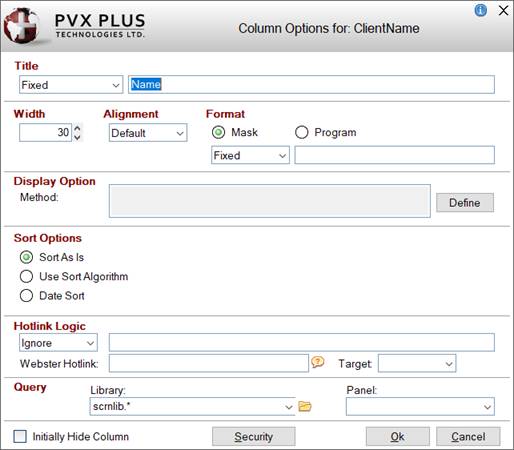
|
Column Options |
For a Data Dictionary/View Definition/Database Table
When you select an item from the File Elements list in the Query Definition window, it is placed in the Columns list with default values for its title, format width and query derived from the data dictionary, view or table definition.
To change the values for a selected element, launch the Column Options window by using one of the following methods:
• Click the Column Options button on the Query Definition toolbar.
• Double click on the element.
• Right click on the element and then select Update column properties from the popup menu.
The Column Options window for the selected element is displayed:
For a Manually-Defined File
When you select a manually defined file from the File Elements list in the Query Definition window and click the selection button, the Column Options window is presented for defining the data element in terms of field number, offset, size and data type. See Field Definition and Manual Field Definition.
The Column Options window consists of the following:
|
(Only Available for Manually-Defined Files)
| |||||||||||
|
Title |
Heading that users will see at the top of the column at run time (either a Fixed value, string Expression or Message Library Reference). | ||||||||||
|
Width |
Column width in columns. This can be adjusted as necessary, depending on the selected font. Column widths can also be adjusted in Query+ Toolbar, Hybrid, Menu and Drop Query views (see Query View option) by clicking the Test/Design toolbar button to display the query and dragging the column header to the desired size. Click the Save + Exit button to save and incorporate these settings into the query definition when exiting the query. (The ability to save query changes when in Test/Design mode was added in PxPlus 2023 Update 1.) | ||||||||||
|
(Query+ and Drop Query) Alignment of the value within the column. Settings include Default, Left, Center and Right justification. The Default setting for text values is Left justification and Right justification for numeric values. Note:
| |||||||||||
|
Format |
Can be either Mask or Program:
| ||||||||||
|
Display Option |
Click the Define button to launch the Query Column Display window where you can assign visual attributes, such as bold text, text color, highlight color, or an image, to a column. See Query Column Display below. | ||||||||||
|
Sort Options |
(String Only, Query+, Drop Query and Classic Query with Sort by Column Option) The following sort options can be assigned to a column: Sort As Is; Use Sort Algorithm; Date Sort:
| ||||||||||
|
(Numeric Only, Query+, Drop Query and Classic Query with Sort by Column Option) (Optional) Tip values to be displayed when the mouse is placed over the column heading. Values include Total, Average, Minimum and Maximum. Column tips are also supported in Webster+ queries. See Webster+ query=xxx. (Webster+ support for column tips was added in PxPlus 2024.) | |||||||||||
|
(Query+ and Drop Query) Logic to execute when the column is double clicked. Click the drop-down arrow for a list of event actions: Ignore, Link, Call and Execute. See Actions and Parameters. The specified logic overrides selecting the query record. Columns with a hotlink are displayed in the color defined by the 'OPTION'("StdLvueHotlinkClr",color$) setting and are underlined while hovering over the column. See OPTION mnemonic.
(The Hotlink Logic option was added in PxPlus 2018.) | |||||||||||
|
Query |
(Classic Query Only) Optional sub-query assigned to the column.
At run time, users can invoke the sub-query by highlighting the column title and clicking the enabled query button on the toolbar. The current contents of the query column are passed as the Start At Value for the sub-query. (Support for entering an expression for a Library name was added in PxPlus 2019.) | ||||||||||
|
Initially Hide Column |
Select this option to initially hide the column at run time until the user selects it to be shown. When using Query+ Toolbar, Hybrid, Menu or Drop Query views (see Query View option), columns can be set to be initially hidden or shown by clicking the Test/Design toolbar button to display the query and selecting the Show/Hide/Reorder Columns item from the Columns run-time option to set the visibility. Click the Save + Exit button to save and incorporate these settings into the query definition when exiting the query. (The ability to save query changes when in Test/Design mode was added in PxPlus 2023 Update 1.) | ||||||||||
|
Launches the Object Security Definition window for setting up column level security for the query. See Query Security. (The Security button was added in PxPlus 2021.) |